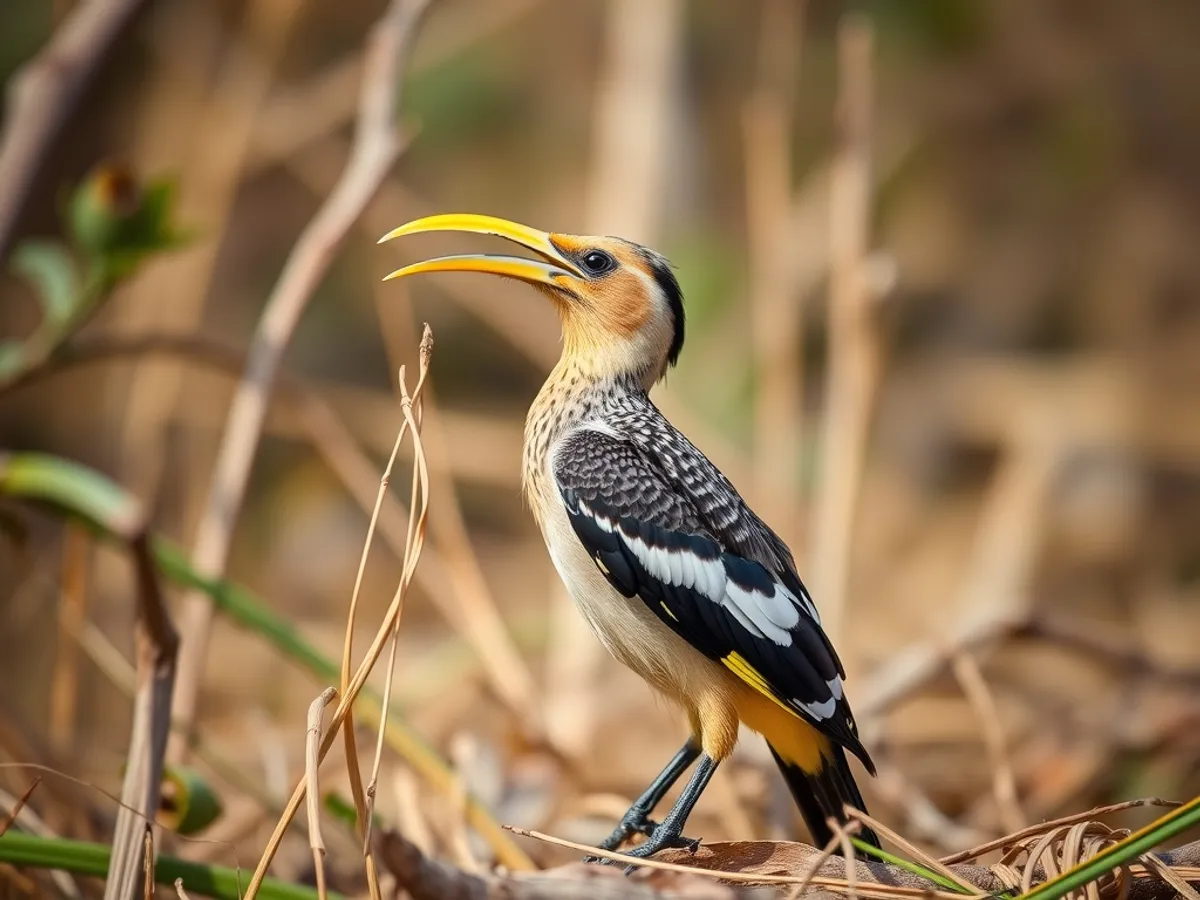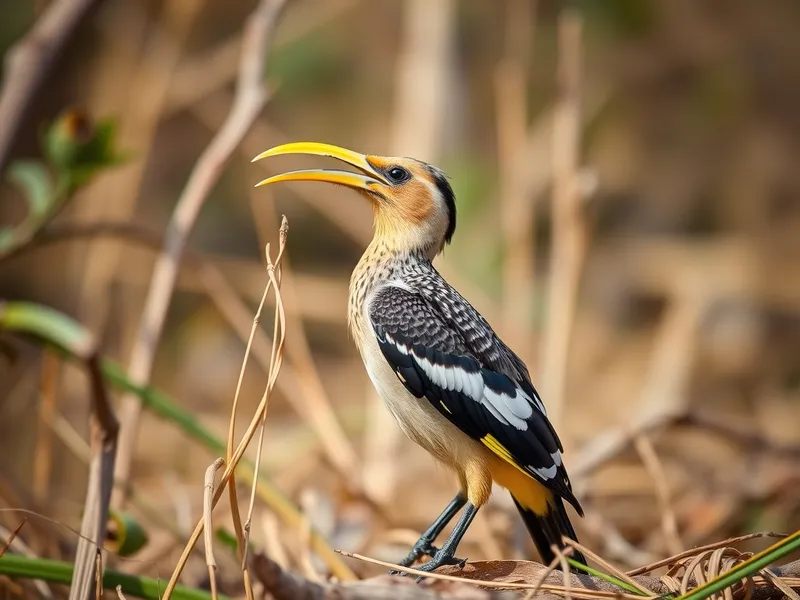
Yellow-billed Oxpecker
Buphagus africanus

Meet the Yellow-billed Oxpecker
The Yellow-billed Oxpecker is a medium-sized bird native to sub-Saharan Africa, recognized by its brown plumage, striking yellow bill with a red tip, and pale rump. It is most often seen perched on large mammals such as buffalo, giraffes, and antelope, feeding on ticks, dead skin, and blood. This species is highly social, living in small flocks and maintaining a close relationship with its mammalian hosts. Their mutualistic behavior benefits both the birds, by providing food, and the mammals, by reducing parasite loads.
Classification
Bird
Habitat
Savanna
Diet
Omnivore
Lifespan
8-10 years
Conservation
Least Concern
Weight
45-57 g
📖Fascinating Facts
Symbiotic Partner
The Yellow-billed Oxpecker forms a mutualistic relationship with large mammals, helping reduce their parasite load while obtaining food.
Tick Specialist
Its diet is mainly ectoparasites like ticks and fleas, but it also feeds on blood and dead skin from wounds.
Early Warning System
Their alarm calls can alert host animals to approaching predators or danger.
📋Detailed Description
The Yellow-billed Oxpecker (Buphagus africanus) is a medium-sized passerine bird, measuring approximately 20 cm (8 in) in length and weighing around 50 grams. Its plumage is predominantly pale brown above with a paler, almost whitish underbelly and a distinctive pale rump. The most striking feature is its robust, slightly decurved bill, which is bright yellow with a red tip—a key distinguishing trait from the closely related Red-billed Oxpecker. The eyes are encircled by a vivid red orbital ring, enhancing its conspicuous facial appearance. Adapted for clinging to large mammals, its feet are strong and zygodactylous, allowing for a firm grip on fur. The Yellow-billed Oxpecker is highly gregarious, often seen in flocks of up to 20 individuals, and is almost exclusively associated with large ungulates such as buffalo, giraffe, antelope, and cattle. Its vocalizations are sharp, chattering calls, often given in flight or while foraging. The species exhibits a mutualistic relationship with its hosts, feeding primarily on ectoparasites like ticks, but also consuming blood and dead skin, sometimes even keeping wounds open to access more blood. This bird is diurnal, spending most of the day foraging on hosts and roosting communally in trees at night. Its range extends across sub-Saharan Africa, favoring open savanna, grasslands, and lightly wooded habitats.
💡 Did you know?
Despite their beneficial reputation, Yellow-billed Oxpeckers sometimes peck at wounds to keep them open and feed on blood, which can slow healing for their hosts.
🔬Research & Sources
Wikipedia Summary
The yellow-billed oxpecker is a passerine bird in the family Buphagidae. It was previously placed in the starling and myna family, Sturnidae.
Last Modified: 12/26/2024
🎭Behavior & Social Structure
Yellow-billed Oxpeckers display complex social behaviors, forming cohesive flocks that forage together and maintain constant vocal contact. Their feeding behavior is specialized: they search for ticks, larvae, and other ectoparasites on the bodies of large mammals, using their bills to part fur and extract prey. They are known to preferentially target engorged ticks, sometimes deliberately keeping wounds open to feed on blood, a behavior termed 'wound feeding.' Oxpeckers exhibit a strong fidelity to their mammalian hosts, often following them for extended periods and switching hosts opportunistically. They communicate with a variety of calls, including sharp 'krik-krik' notes, which may serve to alert hosts to danger or coordinate flock movements. During the hottest part of the day, they may rest in the shade provided by their hosts or nearby trees. Roosting is communal, with birds gathering in dense groups at night in trees or tall shrubs.
👶Reproduction & Life Cycle
Breeding occurs during the rainy season, which varies geographically but generally falls between March and October. Yellow-billed Oxpeckers are monogamous, forming long-term pair bonds. Nests are constructed in tree cavities, often lined with hair plucked from their mammalian hosts. The female lays 2–3 pale blue eggs, which are incubated for about 13–15 days. Both parents share incubation and feeding duties. Chicks are altricial, hatching naked and helpless, and are fed regurgitated insects and ticks. Fledging occurs at around 20–23 days post-hatching, after which juveniles may remain with their parents for several weeks, learning to forage and integrate into the flock.
🛡️Adaptations & Survival
Yellow-billed Oxpeckers have evolved several unique adaptations for their specialized niche. Their strong, curved bills are adept at extracting ticks and larvae from thick fur, while their feet are adapted for clinging to moving hosts. The ability to digest blood and tolerate the anticoagulants in tick saliva is a rare trait among birds. Their muted plumage provides camouflage among the coats of large mammals, reducing predation risk. Behavioral adaptations include acute vigilance, allowing them to detect and respond rapidly to host movements or threats. Their social structure and vocal communication enhance group cohesion and foraging efficiency. The use of mammalian hair in nest lining may provide insulation and parasite deterrence.
📚Research Sources
🎨Cultural Significance
In many African cultures, the Yellow-billed Oxpecker is recognized for its role in controlling livestock parasites and is often seen as a symbol of symbiosis and natural balance. It features in local folklore as a 'tick bird' and is sometimes believed to warn animals of approaching predators through its alarm calls. While not commonly used in traditional medicine or rituals, its presence is valued by pastoralists for the perceived benefits to cattle health. The bird also appears in regional proverbs and stories emphasizing cooperation and mutual aid.
🔬Recent Research & Discoveries
Recent research has focused on the ecological dynamics of oxpecker-mammal interactions, revealing that the relationship can range from mutualistic to parasitic, depending on feeding intensity and host health. Studies using radio-tracking and stable isotope analysis have provided insights into movement patterns and dietary composition. Genetic studies have clarified the evolutionary divergence between Yellow-billed and Red-billed Oxpeckers. Ongoing research is examining the impact of veterinary chemicals on oxpecker populations and the potential for using oxpeckers as bioindicators of ecosystem health. Notably, a 2021 study documented behavioral flexibility in host selection, with oxpeckers increasingly utilizing domestic livestock in areas where wild ungulates are scarce.
🎥Wildlife Videos

The Oxpeckers role in the Animal Kingdom
Is the Oxpecker a friend or foe to its larger mammal hosts? Take a look at one of the most fascinating relationships in the animal ...
WildEarth

Oxpeckers: The Natural Pest Controller | Oxpeckers Role in the Animal Kingdom
"Oxpeckers: The Natural Pest Controller | Oxpeckers Role in the Animal Kingdom" Oxpeckers, also known as tickbirds, are small ...
Familiarity With Animals (FWA)

Oxpecker – Hero or Villain? | WILD NATURE
Oxpeckers – Heroes or Villains? | WILD NATURE It seems as though the jury is still out on whether the oxpecker is a hero or a ...
Lion Mountain TV

Oxpecker Nature's Bug Remover
wildlife #Oxpecker #zoo Providing visual and audio sensation in abundance! INSTAGRAM: ...
Quantity Vibes

Animal and Birds happy together | Yellow-billed oxpecker | Rhino | Deer | Hippo
The wildlife media brings you awesome videos of wildlife such as birds, animals, and beautiful nature sights. You will enjoy the ...
Nature Notes

Yellow-billed Oxpecker (Buphagus africanus) Bird Call & Video | Oxpeckers | Stories Of The Kruger
Visit Our Website: www.storiesofthekruger.co.za Like Us On Facebook: https://www.facebook.com/StoriesOfTheKruger/ Follow Us ...
Stories Of The Kruger
🌍Habitat Information
The Yellow-billed Oxpecker typically inhabits Savanna environments. Yellow-billed Oxpeckers have adapted to their environments with specialized features and behaviors.
Primary Habitat:
Savanna
More detailed habitat information will be available soon.
🛡️Conservation Status
The Yellow-billed Oxpecker is currently classified as Least Concern. Conservation efforts are crucial for preserving this species for future generations.
Common Threats:
- 🏠Habitat loss and fragmentation
- 🌡️Climate change impacts
- 🎯Hunting and poaching
- 🏭Human-wildlife conflict
⚠️Threats & Conservation Challenges
Currently assessed as Least Concern by the IUCN, the Yellow-billed Oxpecker faces localized threats from habitat loss, overgrazing, and the decline of large wild ungulate populations. The widespread use of acaricides and insecticides on livestock can reduce tick availability and may be toxic to oxpeckers, leading to population declines in some areas. However, their adaptability to both wild and domestic hosts has allowed them to persist across much of their range. Conservation challenges include maintaining healthy populations of large mammals and promoting sustainable livestock management practices. Population trends are generally stable, but regional declines have been noted where intensive agriculture or chemical use is prevalent.
🔬Scientific Classification
Scientific Name
Buphagus africanus
Classification Hierarchy
🔍 About Taxonomic Classification
Taxonomic classification is a hierarchical system used by scientists to classify and organize living organisms based on shared characteristics and evolutionary relationships.
The system moves from broad categories (Kingdom) to increasingly specific ones, with each animal's scientific name typically consisting of its Genus and species.
📝Community Notes
Share your observations and insights about the Yellow-billed Oxpecker with our community of wildlife enthusiasts.
Join Our Community
Sign in to share your observations and connect with fellow wildlife enthusiasts.
Sign In to ContributeNo community notes yet
Be the first to share your observations about the Yellow-billed Oxpecker!
Explore Yellow-billed Oxpecker
Select a tab above to learn more about this amazing animal.
📸Photo Gallery
No photos available for this animal yet.
🌟Discover More Wildlife
Continue your journey of discovery with more fascinating animals from our database
